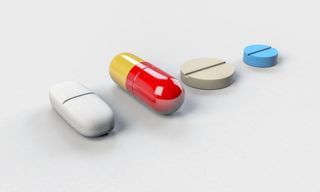Addiction
Drug Addiction vs. Drug Dependence
The important difference is often misunderstood—and it is no wonder.
Posted March 6, 2020 Reviewed by Jessica Schrader
It is no secret that misinformation about addiction is rampant in popular media. One particular area of misinformation concerns how the use of language is employed when describing topics related to addiction. If you have ever found yourself reading or warily chiming into discussions on social media about addiction, you might quickly get sucked into a world of confusion as you observe all sorts of people—medical professionals, journalists, parents, people who use substances, people in recovery, etc.—incessantly argue over the definitions of terminology, such as "addiction," "dependence," "abuse," "misuse," "habit-forming," "recreational use," "medicinal use," etc.
In my experience as a clinical psychologist who specializes in the assessment and treatment of concurrent addictive and psychiatric disorders, one of the most important and commonly confused distinctions is that between "addiction and "dependence." And it is no wonder.
The scientific construct of addiction has a rich and evolving history. Even the people who dedicate their lives to researching addiction, and who are responsible for the very medical texts that we use to diagnose addiction, haven't been able to arrive at a clear consensus about which terms should be used.

A bit of contentious history
One of the main medical texts that are used by mental health professionals to diagnose addiction is the Diagnostic and Statistical Manual of Mental Disorders (the DSM), which is currently in its fifth edition.
In the 1980s, a committee of experts met to revise what was at the time the DSM-III, and after much debate over whether the term "addiction" should be used versus "dependence," the word "dependence" was chosen by a margin of only a single vote, mainly due to some of the committee members believing that the word "addiction" was pejorative. As a consequence, the diagnostic category of "substance dependence" stayed with us through the DSM-IV, until it was dropped in 2013 in the DSM-5, along with the diagnostic category of "substance abuse."
The solution in the DSM-5 was to combine the categories of "substance dependence" and "substance abuse" into one category called "substance use disorder" under a chapter heading called Substance-Related and Addictive Disorders. The purposeful use of the term "Addictive Disorders" in the naming of this chapter was primarily due to the addition of "gambling disorder" to the DSM, a non-substance-related disorder. And here, too, among the committee members, the decision to introduce the term "addictive" into the DSM-5 was arrived at through disagreements and non-consensus.
Here's the biggest source of confusion
If that history lesson sounded confusing, that's because it is, and there's no way to simplify what happened. But the biggest source of confusion concerns the word "dependence." Prior to the DSM-III, the term "dependence" simply meant physiological dependence, as indicated by tolerance and withdrawal symptoms.
Unfortunately, the DSM-III committee expanded the definition of "substance dependence" to include not only physiological symptoms of tolerance and withdrawal but also other psychological and social symptoms, such as uncontrolled use and negative psychological and social consequences as a result of drug use.
Thus, the medical world was left with two very different definitions of dependence: one that signified physical dependence, and one that signified a more complicated kind of biopsychosocial dependence, which in reality was used as a proxy to diagnose addiction.
How do we define addiction and dependence today?
With the removal of the category "substance dependence" from the DSM-5, the definition of dependence should be clearer: Dependence means physical or physiological dependence as indicated by tolerance and withdrawal symptoms. It is a state of neuroadaptation that can occur after repeated substance use, whereby continued substance use is needed to prevent withdrawal symptoms. Dependence does not equal addiction, though it can be one feature of addiction.
The term "addiction" is much more complicated, and there still remains considerable debate in the medical community about exactly how to define it—for example, whether it's best conceptualized within a disease model, a learning model, or something in between.
Medically, and in practice, addiction is most often diagnosed using the DSM-5 category of substance use disorder. Unhelpfully, however, nowhere in the DSM-5 is this explicitly and transparently mentioned. In fact, the American Psychiatric Association (APA), who are the developers of the DSM, nonchalantly utilize the terms "substance use disorder" and "addiction" interchangeably on their website.
In medical practice, to get a diagnosis of a substance use disorder, there first needs to be a careful diagnostic interview conducted by a mental health professional. The interviewer assesses whether there is a problematic pattern of substance use or behaviors that are causing a person distress and impairment in their functioning to the point that it's considered clinically significant.
In addition, a person needs to meet at least two of these 11 symptoms:
- Repeated use, resulting in a failure to fulfill major role obligations
- Repeated use in hazardous situations
- Continued use despite social/interpersonal problems
- Cravings
- Tolerance
- Withdrawal
- Use for longer periods or in larger amounts than intended
- Persistent desire or unsuccessful attempts to control the use
- A great deal of time spent on activities related to the use
- Reduced important social, occupational, or recreational activities
- Continued use despite physical or psychological problems
Can someone be dependent without being addicted?
Absolutely.
Physiological dependence is very common and can occur with many different kinds of substances, including those considered to be medications. In fact, it's very important for medical professionals to get this right and differentiate between physiological dependence and the more complicated addiction construct because the diagnosis will help point to the best treatment option.
Can someone be addicted without being dependent?
This is a much tougher debate, but the short answer is yes.
According to the DSM-5, it is possible to meet diagnostic criteria for a substance use disorder without having tolerance and withdrawal symptoms. That said, for many, but not all, substances, tolerance and withdrawal are often part of the package of symptoms of a substance use disorder.
Also, in my experience, some professionals somewhat arbitrarily consider a substance use disorder to be an addiction only in cases where a "severe substance use disorder" can be diagnosed, as indicated by six or more of the 11 DSM-5 symptoms—which often includes tolerance and withdrawal.
Why does this matter?
My hope for this article was that it would help to clarify, rather than further confuse, the distinction between addiction and dependence. It has become increasingly clear to me that the distinction is not only confusing among non-experts but among medical professionals as well.
Even the Centers for Disease Control and Prevention (CDC) is obviously confused about the distinction, as evidenced by the terminology page on their website, which states, "Drug addiction—The preferred term is substance abuse disorder." This is false. To reiterate, the DSM-5 dropped the categories of "substance dependence" and "substance abuse," and so the claim that substance abuse disorder is the preferred term for drug addiction is inaccurate.
While much of the confusion about this topic can be traced to DSM committees, I would caution against an oversimplified blame game. The topic itself is inherently complicated and confusing, and it's situated in the context of an evolving medical and cultural milieu.
At the same time, the distinction between addiction and dependence is not trivial. Medical professionals are ethically required to get the diagnosis right so that they can get the treatment right.
A version of this post was also published by Scientific American.




